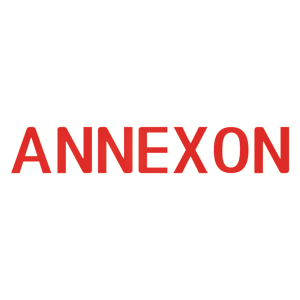Annexon Provides Update on ARCHER II Global Registrational Program in Geographic Atrophy
Rhea-AI Summary
Annexon Inc (ANNX) has initiated patient dosing in the global Phase 3 ARCHER II trial for ANX007, a C1q inhibitor targeting geographic atrophy (GA). The trial aims to evaluate ANX007's potential to protect vision in GA patients, with topline data expected in H2 2026. New data from the Phase 2 ARCHER trial showed:
1. Significant vision protection in standard and low light conditions
2. Structural protection in key retinal areas for visual acuity
3. Up to 60% protection of photoreceptors in the central fovea
4. 29% protection of photoreceptors across the full retinal field
ANX007 is the only GA therapy candidate to receive PRIME designation in the EU and Fast Track designation from the FDA. The Phase 3 trial will enroll approximately 630 patients, using best corrected visual acuity (BCVA) protection against ≥15-letter loss as the primary outcome measure.
Positive
- Initiated patient dosing in Phase 3 ARCHER II trial for ANX007 in geographic atrophy
- Phase 2 ARCHER trial showed significant vision protection in standard and low light conditions
- Demonstrated up to 60% protection of photoreceptors in the central fovea
- Received PRIME designation in EU and Fast Track designation from FDA
- Phase 3 trial to enroll approximately 630 patients
Negative
- Topline data from Phase 3 ARCHER II trial not expected until second half of 2026
News Market Reaction 1 Alert
On the day this news was published, ANNX declined 9.38%, reflecting a notable negative market reaction.
Data tracked by StockTitan Argus on the day of publication.
Patient Dosing Initiated in Phase 3 ARCHER II Trial of C1q Inhibitor ANX007; Topline Data Expected in Second Half 2026
Additional Data from Phase 2 ARCHER Trial Demonstrated Both Significant Vision Protection in Standard and Low Light Conditions, and Significant Structural Protection in Regions of the Eye Important for Visual Acuity
BRISBANE, Calif., Aug. 05, 2024 (GLOBE NEWSWIRE) -- Annexon, Inc. (Nasdaq: ANNX), a biopharmaceutical company advancing novel complement therapies for neuroinflammatory diseases of the body, brain and eye, today announced patient dosing was initiated in the global pivotal Phase 3 ARCHER II trial evaluating ANX007 for the treatment of geographic atrophy (GA), the only GA pivotal program utilizing visual protection as the global regulatory-aligned primary end point. Additionally, Annexon announced new data regarding protection of vision and vision-related retinal structure from the Phase 2 ARCHER trial, supporting the disease modifying potential of ANX007 for the treatment of GA. These data were recently presented on July 18, 2024, at the American Society of Retina Specialists (ASRS) Annual Scientific meeting.
GA is a chronic, progressive neurodegenerative disease that is the leading cause of blindness for over 8 million elderly people worldwide, resulting in the loss of independence and major disruption in their daily lives. Although there are two currently FDA-approved treatments to slow disease progression in GA, there are currently no approved treatments indicated to protect vision in GA.
“ANX007 is the only investigational medicine for GA to date to show in a randomized clinical trial significant protection of both visual acuity and key visual structures in regions of the eye essential for vision,” said Douglas Love, president and chief executive officer of Annexon. “These data underscore ANX007’s potential best-in-class profile and make all the more exciting the initiation of the ARCHER II global, pivotal Phase 3 study designed to treat patients impacted by this devastating disease at a vulnerable stage in their lives. Assuming success in the ARCHER II trial, ANX007 has the potential to be the first GA therapy approved to protect vision.”
ARCHER II is a global, randomized, sham-controlled Phase 3 trial with topline data expected in the second half of 2026. The ANX007 registrational program has received regulatory alignment with both the Food and Drug Administration (FDA) and the European Medicines Agency (EMA) on key study elements, including on using, for the first-time in GA, best corrected visual acuity (BCVA) protection against ≥15-letter loss as the primary outcome measure (equivalent to three lines on a standardized eye chart). In ARCHER II, ANX007 will be compared to sham control in a well-powered study with a robust safety database that is expected to enroll approximately 630 patients. ANX007 is the only therapeutic candidate for GA to date to receive Priority Medicine (PRIME) designation in the European Union, and has been granted Fast Track designation from the FDA.
Eleonora Lad, MD, PhD, Vice Chair of Clinical Research at Duke Eye Center added, “Treatments for GA have primarily focused on addressing lesion growth by measuring protection of the retinal pigment epithelium (RPE), supportive cells that do not detect light across the retina. Unfortunately, current treatments have not translated to protection of clinically meaningful vision for patients. The new analyses of the Phase 2 ARCHER trial are very encouraging, demonstrating protection of photoreceptors in the central fovea, the region of the retina needed for important activities such as reading, driving and seeing faces. These data shed new insights into the mechanism of ANX007 to potentially modify disease activity, leading to protection of vision loss in GA.”
Data highlights from the ARCHER Phase 2 analyses presented at the ASRS Annual meeting include:
ANX007 provided broad-based protection of vision vs. sham-treated eyes
- Statistically significant and dose dependent protection of vision measured by best corrected visual acuity (BCVA) protection against ≥15-letter loss at month 12, which represents three lines on the standard Early Treatment of Diabetic Retinopathy Study (ETDRS) eye chart and is a widely accepted clinically meaningful assessment of visual acuity (
21.3% (sham) vs.5.6% (ANX007 monthly); p = 0.0021) - Statistically significant protection of vision in low light conditions, low luminance visual acuity (LLVA) at month 12, which is an important assessment of visual performance for everyday activity (LLVA ≥15-letter loss at month 12:
20.3% (sham) vs.7.6% (ANX007 monthly); p = 0.022)
ANX007 provided structural protection in regions of the retina critical for visual acuity
- Photoreceptors are neurons in the retina responsible for detecting light, and thus protecting their structure is essential for protecting vision
- ANX007 provided up to
60% protection of photoreceptors compared to sham within the central 1.5 mm of the fovea, as measured by ellipsoid zone (EZ) through 12 months (p = 0.0319*) - ANX007 provided
29% protection of photoreceptors across the full retinal field as measured by EZ through 12 months (p = 0.017*) - ANX007 demonstrated a trend of protection against RPE loss in the central foveal subfield, the region where RPE loss best correlates with vision loss (
18% protection of RPE loss, p = 0.40*). RPE loss is a measure that lags behind photoreceptor loss.
*nominal p-value
About ANX007
ANX007 is a non-pegylated antigen-binding fragment (Fab) antibody designed as a first-in-kind therapeutic to selectively inhibit C1q, a key driver of neurodegeneration. In geographic atrophy (GA), C1q binds to photoreceptor synapses early in the disease process, causing inflammation, synapse loss, and neuronal damage that results in vision loss. Vision loss precedes the loss of retinal pigment epithelium (RPE), the traditional biomarker used for previous Food and Drug Administration (FDA) approvals in GA. Intravitreal administration of ANX007 fully stops C1q and activation of its inflammatory pathway. In the Phase 2 ARCHER trial, ANX007 was shown to preserve vision on multiple measures and provided significant structural protection within the retina, particularly of photoreceptors in the central fovea that are important to visual acuity. Additionally, ANX007 was generally well-tolerated through month 12, with no increase in choroidal neovascularization (CNV) rates between the treated and sham arms and no events of retinal vasculitis reported. ANX007 has been granted Fast Track designation from the FDA and is the first therapeutic candidate for the treatment of GA to receive Priority Medicine (PRIME) designation in the European Union, which provides early and proactive support to developers of promising medicines that may offer a major therapeutic advantage over existing treatments or benefit to patients without treatment options.
About Phase 3 ARCHER II Trial
ARCHER II is a global, randomized, double-masked, sham-controlled Phase 3 trial expected to enroll approximately 630 patients with geographic atrophy (GA) secondary to age-related macular degeneration who will be randomized 2:1 to receive a monthly dose of ANX007 or sham procedure. The primary endpoint is the prevention of ≥15-letter loss of best corrected visual acuity (BCVA), which represents three lines on the standard Early Treatment of Diabetic Retinopathy Study (ETDRS) eye chart. The primary analysis will occur between 12 and 18 months from dosing initiation based on the accumulation of target events (patients in the overall study experiencing BCVA ≥15-letter loss on consecutive visits). Proportion of patients experiencing BCVA ≥15-letter loss is a well-established functional endpoint that has served as the basis for numerous ophthalmology drug approvals by the Food and Drug Administration (FDA) and European Medicines Agency (EMA). Secondary endpoints in ARCHER II include safety, low-luminance visual acuity (LLVA), and photoreceptor integrity (EZ). Topline data are expected in the second half of 2026.
Plans for an injection-controlled study, ARROW, to assess the prevention of ≥15-letter loss of BCVA, are also ongoing.
About Geographic Atrophy
Geographic atrophy (GA) is an advanced form of dry age-related macular degeneration (AMD), an eye disease that is the leading cause of blindness in the elderly. GA is a chronic progressive neurodegenerative disorder of the retina involving the loss of photoreceptor synapses and cells in the outer retina. GA affects an estimated one million people in the United States and eight million people globally, severely limiting their independence and causing frustration, anxiety and emotional hardship. Effective treatments that preserve vision are still needed, as no currently approved therapies have been shown in clinical trials to significantly protect vision.
About Annexon
Annexon Biosciences (Nasdaq: ANNX) is a biopharmaceutical company advancing a late-stage clinical platform of novel therapies for people living with devastating classical complement-mediated neuroinflammatory diseases of the body, brain, and eye. Annexon’s novel scientific approach targets upstream C1q to block the classical complement inflammatory cascade before it starts, and its therapeutic candidates are designed to provide meaningful benefits across multiple autoimmune, neurodegenerative and ophthalmic diseases. With proof-of concept data in Guillain-Barré syndrome, Huntington’s disease and geographic atrophy, Annexon is rigorously advancing its mid-to late-stage clinical trials to bring their potential treatments to patients as quickly as possible. To learn more visit annexonbio.com.
Forward Looking Statements
This press release contains forward-looking statements within the meaning of Section 27A of the Securities Act of 1933, as amended, and Section 21E of the Securities Exchange Act of 1934, as amended. In some cases, you can identify forward-looking statements by terminology such as “aim,” “anticipate,” “assume,” “believe,” “contemplate,” “continue,” “could,” “design,” “due,” “estimate,” “expect,” “goal,” “intend,” “may,” “objective,” “plan,” “positioned,” “potential,” “predict,” “seek,” “should,” “suggest,” “target,” “on track,” “will,” “would” and other similar expressions that are predictions of or indicate future events and future trends, or the negative of these terms or other comparable terminology. All statements other than statements of historical facts contained in this press release are forward-looking statements. These forward-looking statements include, but are not limited to, the ability of ANX007 to block upstream C1q, the clinical and regulatory status of ANX007; ANX007’s distinct potential neuroprotective mechanism of action and potential to provide protection from vision loss; the potential of ANX007 to become best-in-class treatment for GA; the potential therapeutic benefit of ANX007; the anticipated timing of data from the Phase 3 ARCHER II trial and plans for the Phase 3 ARROW trial; and Annexon’s ability to rigorously advance mid- to late-stage clinical trials and continue development of the company’s portfolio. Forward-looking statements are not guarantees of future performance and are subject to risks and uncertainties that could cause actual results and events to differ materially from those anticipated, including, but not limited to, risks and uncertainties related to: the ongoing off-treatment follow-up portion of the ARCHER trial and final results from the ARCHER trial; the company’s history of net operating losses; the company’s ability to obtain necessary capital to fund its clinical programs; the early stages of clinical development of the company’s product candidates; the effects of public health crises on the company’s clinical programs and business operations; the company’s ability to obtain regulatory approval of and successfully commercialize its product candidates; any undesirable side effects or other properties of the company’s product candidates; the company’s reliance on third-party suppliers and manufacturers; the outcomes of any future collaboration agreements; and the company’s ability to adequately maintain intellectual property rights for its product candidates. These and other risks are described in greater detail under the section titled “Risk Factors” contained in the company’s Annual Report on Form 10-K and Quarterly Reports on Form 10-Q and the company’s other filings with the SEC. Any forward-looking statements that the company makes in this press release are made pursuant to the Private Securities Litigation Reform Act of 1995, as amended, and speak only as of the date of this press release. Except as required by law, the company undertakes no obligation to publicly update any forward-looking statements, whether as a result of new information, future events or otherwise.
Investor Contact:
Joyce Allaire
LifeSci Advisors, LLC
jallaire@lifesciadvisors.com
Media Contact:
Sheryl Seapy
Real Chemistry
949-903-4750
sseapy@realchemistry.com










